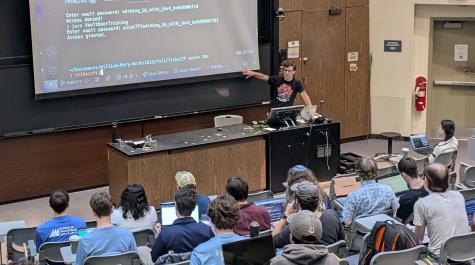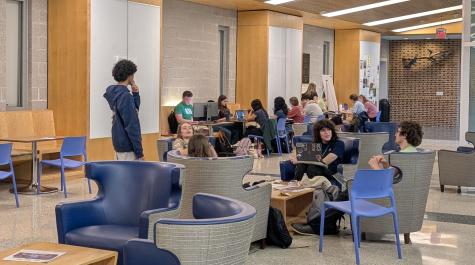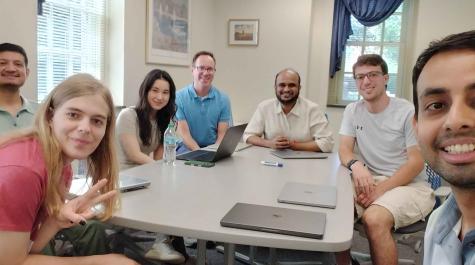Code, Crack, Conquer: TribeCTF Brings Together Students and Cybersecurity
Year two of TribeCTF, William & Mary’s Capture-the-Flag (CTF) cybersecurity competition, saw a growing number of participants spend two days racing against the clock to solve as many challenges as possible for both prizes and bragging rights in the fast-growing world of cybersecurity.
What began just last year as a mostly local contest has now nearly doubled in size, drawing just under 100 participants, with teams coming from William & Mary, Arizona State University, Christopher Newport University, George Mason, Georgia Tech, Old Dominion University, Rowan University, the University of Virginia, and Virginia Tech.
“Last year we had around 50 to 60 participants, mostly William & Mary teams,” said Nicolas Janis ‘26, a computer science major and one of the competition’s organizers. “This year it’s closer to a 50/50 split with schools across the country.”
CTF competitions turn complex cybersecurity tasks into solvable puzzles. Participants sift through forensic data, decode hidden messages, analyze malware, or probe hardware vulnerabilities.
“Cybersecurity is one of the few disciplines that’s been able to gamify itself,” Janis explained. “You can be a middle schooler with a laptop, Googling and playing with challenges, and you’re already learning skills that translate to the real world.”
This year’s TribeCTF included 18 problems ranging from beginner-friendly ciphers to advanced exercises modeled after real-world malware. Kevin Wang ’29 compared the format to Jeopardy, where you can solve some of the easier problems for less points and work your way up to the harder challenges.
“The first couple of hours or so was just familiarizing myself with a CTF and what the different aspects are like,” said Wang. “I remember getting the first 1000 [point] problem and that was really rewarding.”
Wang was one of several first-year students who competed after learning of the competition in his COLL 100 class, “Smashing LLMs for Fun and Profit” with Yue Xiao, an Assistant Professor of Computer Science. Xiao told her students this year’s competition would double as a live research lab, exploring how humans collaborate with artificial intelligence in solving cybersecurity problems.
Xiao and Dr. Adwait Nadkarni, the director of William & Mary’s Cybersecurity Center, deployed a custom AI agent with cybersecurity-specific tools and reference materials, though competitors who opted into the study were also able to use their preferred AI platforms.
“AI is very powerful, but whether there are limitations, we want to analyze when something goes wrong how the human-AI collaboration pattern is, whether the human just blindly follows the AI response or the human actually leads the conversation,” stated Xiao.
Being able to use AI was a welcome boost for those who were new to cybersecurity or a CTF competition.
“When it comes to cybersecurity, which is something that I'm not too familiar with, I think AI provided a stepping stone,” said Wang. “Of course you have to do a lot of the manual thinking yourself, a lot of the problem solving, but when it comes down to like, oh here is this strategy that I want to implement, it executes that very well, but I find when it comes to actually thinking for itself, there are some improvements to be made.”
Beyond the competition, TribeCTF has become a recruiting ground for William & Mary’s budding cybersecurity community. The event feeds into TribeCyber, W&M’s student cybersecurity club, and helps identify talent for national-level competitions.
Janis, who was on the team that finished second in last year’s National Cyber League, sees TribeCTF as both outreach and pipeline building.
“This event helps us find people who are interested and say, ‘Hey, why don’t you come try competing with us on a bigger stage?’ It’s how we’ve gone from almost no cybersecurity presence a few years ago to having teams finishing in the top 50 nationally,” stated Janis.
For Wang, his first CTF was a tremendous experience and he said is excited to compete again next year.
“It was a great learning opportunity because it condenses a lot of different aspects of cybersecurity, like cryptography and coding, and I think it really helped me understand more about cybersecurity in general and has strengthened my overall understanding of it,” explained Wang. “I swear every single hour I was experimenting something new.”
TribeCTF 2025 Results
1st Place – MasonCC
2nd Place – CNS@Uva
3rd Place – honey bee’s
This article was created with the help of OpenAI's ChatGPT-5. All content was reviewed and edited by the communications team.



